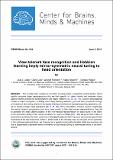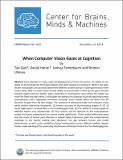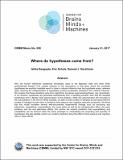Browsing CBMM Memo Series by Title
Now showing items 137-141 of 141
-
View-tolerant face recognition and Hebbian learning imply mirror-symmetric neural tuning to head orientation
(Center for Brains, Minds and Machines (CBMM), arXiv, 2016-06-03)The primate brain contains a hierarchy of visual areas, dubbed the ventral stream, which rapidly computes object representations that are both specific for object identity and relatively robust against identity-preserving ... -
Visual concepts and compositional voting
(Center for Brains, Minds and Machines (CBMM), 2018-03-27)It is very attractive to formulate vision in terms of pattern theory [26], where patterns are defined hierarchically by compositions of elementary building blocks. But applying pattern theory to real world images is very ... -
What am I searching for?
(Center for Brains, Minds and Machines (CBMM), arXiv.org, 2018-07-31)Can we infer intentions and goals from a person's actions? As an example of this family of problems, we consider here whether it is possible to decipher what a person is searching for by decoding their eye movement behavior. ... -
When Computer Vision Gazes at Cognition
(Center for Brains, Minds and Machines (CBMM), arXiv, 2014-12-12)Joint attention is a core, early-developing form of social interaction. It is based on our ability to discriminate the third party objects that other people are looking at. While it has been shown that people can accurately ... -
Where do hypotheses come from?
(Center for Brains, Minds and Machines (CBMM), 2016-10-24)Why are human inferences sometimes remarkably close to the Bayesian ideal and other times systematically biased? One notable instance of this discrepancy is that tasks where the candidate hypotheses are explicitly available ...





